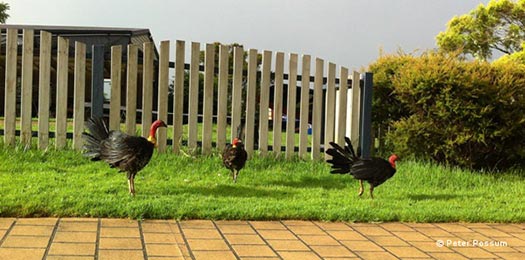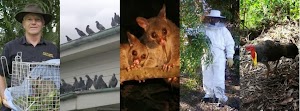1. ANIMAL DESCRIPTION
Common name: Australian Brush Turkey (Scrub Turkey / Brush Turkey)
Scientific name: Alectura lathami
SIZE
Adult size when fully grown is around 600mm to 750mm long for both the male and female brush turkey.
WEIGHT
Adult weight when fully grown is around 2.0 to 2.2 kilograms.
PLUMAGE
Brush turkeys have black feathers on its main body with white speckled feathers on its chest. It has a red skinned head and a medium sized beak. Its tail feathers are a larger fan shaped arrangement that gives the turkey a long looking body shape.
The male brush turkey has a darker red / brown skinned head than the female. In Brisbane the male brush turkey has a yellow wattle which is larger on older birds. It hangs as a fleshy lobe at the base of the neck.
The bird’s wattle varies in colour with its age, gender and location. In the southern parts of its range, its usually yellow, though pink and white have been recorded and in far north Queensland its wattle is light blue. Females and younger birds have dull yellow wattles.
During the breeding season this yellow neck flap area is displayed to promote his maturity for territorial and breeding dominance, to attract females and warn other male brush turkeys that enter his territory.
It has been recorded that older females can mature to develop a noticeable wattle of yellow skin on their necks and so be mistakenly identified as a younger male.

Turkeys Warming In the Sun
FEATURES
The brush turkey is a megapode, a group of birds that incubate their eggs in a mound. There as 3 species in Australia, the Orange Footed Scrub Fowl, the Mallee Fowl and the Australian Brush Turkey.
When young megapodes hatch out of the egg, they are fully feathered and have very well developed legs because they have to dig their way out of their nest and then run on the first day of life and must be able to fly up into bushes and trees to escape predators. Of all the birds in the world, they are thought to be the most developed at hatching. They get no help from their parents. Remarkable!
The Australian Brush Turkey is a ground dwelling bird with an unorthodox flying pattern. Turkeys do roost in trees at night for safety and to escape the heat of the day, but they prefer to scratch around in the undergrowth and hop onto lower branches.
Like the young, the adults have very strong legs mainly used for scratching in the surface soil and leaf litter to find food, and for the male only, to build the nest.
2. ECOLOGY
The brush turkey is widely found throughout the tropical coastal regions of Queensland and New South Wales. Its preferred habitat is humid tropical rain forests but any vegetated areas with a ground cover of leaf litter or organic mulch will attract and hold a turkey.
One urban ecologist Darryl Jones has being studying the bird since 1983. Professor Jones says until the 1950s they weren’t endangered but they were extremely rare, due to people hunting them, especially during the depression.
In the 1970s they were found in Mount Coot-tha, Corinda, Indooroopilly and Chapel Hill. The laws brought in to protect the brush turkey have caused a dramatic recovery of their population. By 1983 they were found in 27 Brisbane suburbs.
Records show that in Brisbane 40 years ago brush turkeys were only found in a few suburbs in much smaller numbers than today. Since then the numbers have risen dramatically to the point they can be found in every suburb of Brisbane in parks and residents backyards of every suburb of Brisbane. The scrub turkey has few predators and humans do not seem to scare the bird.
Their diet consists mainly of foraged fruits and berries that have dropped to the floor of the forest or inhabitable area. It will also gladly eat seeds, roots, grubs worms, snails, insects and even small reptiles. They are an opportunistic scavenger trying any food and inspecting rubbish bins.
Sometimes a small group of young birds will stay together but the brush turkey is usually solitary except in breeding season when it is often found in a small group consisting of a dominant male with several female birds. From the day they hatch out of the egg they fend for themselves: since they get no parental guidance every basic behaviour is genetically programmed.
3. BEHAVIOUR
In the breeding season the brush turkey male will create an impressive mound of composting mulch and fallen leaves. The nest can be up to 1.5 metres high and 2 to 4 metres across. The nest’s size is an attractive feature to the female brush turkey.
The male’s job in life is to build a compost heap that will attract as many females as possible. He requires any female that wants to lay her eggs in his compost heap to mate with him and a really successful male will mate with up to twelve different females over a period of time. Once laid, the eggs of megapodes are abandoned by the females and the male, simply maintains the mound.
To attract the female brush scrub turkey the male has a more vivid colouration of his red head and increased yellow skin folds around his neck during the breeding season. The female will inspect and tests the nest for its suitability and especially its temperature to ensure the best incubation results for her eggs.
One large dominant male will try to exclude other males from the area around his nest mound. When another male approaches, their yellow neck folds are inflated, the tail is fanned out and with the head held high they dance about and produce a low booming call and chase each other to establish dominance of the nest and its nearby territory.
4. BREEDING
The brush turkey’s usual breeding season is between August to January but some birds will try all year. During mating season the male may court and successfully mate with many females. Each will lay her eggs in his mound for him to guard up to the point of hatching. Each female can lay 20 or more eggs in a season with an interval of 2 or 3 days between laying each one. The nest can hold up to 150 eggs if he is an attractive male but 40-60 is more common.
Several females may lay their eggs in the one mound (nest) that the male has energetically created. The eggs are laid at a depth of around 60 to 80cms and usually spaced about 20 to 30 cms apart from each other. The decomposing vegetation gives off heat that incubates the eggs. Scientists have demonstrated that brush turkey eggs are temperature sensitive. The typical temperature of the nest is 33-35 degrees Celsius. When the eggs are incubated above 34 degrees, an increase of female chicks will hatch. When the eggs are incubated below 34 degrees the eggs produce a higher % of male chicks. This is similar to the scenario for reptile eggs including crocodiles. However the temperature of these nests is rather unpredictable and easily influenced by weather events such as prolonged rain or heatwaves. The hatching rate of the eggs falls if the nest temperature is too high or low for more than a brief period.
The heat in the nest is generated by the decomposing (rotting) of the organic material mixed with the soil and naturally occurring leaf litter bacteria and organisms. The male will check the temperature of the nest using a special temperature sensing organ at the base of his beak. He will then make physical adjustments to the mound, adding or removing material to either cool the nest or increase the heat in the nest according to his temperature measurements.
The eggs are very large. They have among the largest yolk content of any bird species and that is because the chicks that are going to hatch must be so well developed, at the time that they hatch. Their bodies are still covered in down, but they have fully developed flight feathers, so that they can fly on their first day of hatching. No other species is that advanced.
The chicks hatch about a half a metre below the surface and the first thing they have to do is dig their way out from the bottom of a pile of sticks dirt and leaves. The chick then runs off alone into the rainforest, where it has to fend for itself, find food, evade predators, find a place to roost for the night
The incubation of the eggs takes around 7 weeks. The young chick is often chased away from the nest by the male who fails to recognise it as one of his own kind. There is no parental care at all!
Chicks are very susceptible to mortality in their early days and weeks of life. They are common food sources for goannas, snakes, birds of prey, cats and dogs. It is reported that only one in 200 baby brush turkeys will make it to their first birthday, as they rely on luck and instinct to survive without any parental guidance.
5. HOME OWNER PROBLEMS
Due to the brush turkey’s success in adapting to the built environment of the human population it has been labelled as a pest in some areas. It does cause damage to residential gardens when the male constructs its huge nest.
Some people feed them which is not advisable and encourages the animals to claim urban gardens as its territory and commence nesting.
In some cases, feeding wild birds has attracted as many as fifteen brush turkeys into their garden every afternoon, mainly females. They roost in the nearby trees at night. A group of adult females scratching the garden for food can be worse than a single nesting male and can destroy a garden, in the space of a few hours, scratching up plants and soil with leaves and mulch.
Be warned – once the male has chosen a nesting site and commenced mounding it is almost impossible to stop. As an Australian native animal it is protected and cannot be harmed. However, licensed operatives like us at Peter the Possum & Bird Man have a permit to trap and get rid of turkeys humanely.
Other options include covering the nest with a heavy tarp and creating a substitute nesting mound in a less valuable spot in your garden to encourage the male to take interest in a new site. Even compost heaps can be adopted as a ‘ready made’ nest by a male. Many nests are located under a tree so that it can provide shade for the nesting mound on hot days, but they will avoid sites that have no sun at all. So if practical the trees above the nest could be removed to expose the site to full sun, but the brush turkey make may simply move the nest a few metres sideways. Turkeys often prefer hill top sites, especially if there is lots of mulch nearby.
A circular guard of metal mesh around young trees is effective in protecting their roots and stopping them from being dug up. Sensitive plants can be protected by covering with a ‘cage’ of metal mesh, until they are large enough to resist damage. There are NO effective repellants, as far as we know, inspite of claims to the contrary. Ultrasonic noises and other scare methods do not work, sometimes a dog can help but even some dogs just give up.
Instead of organic mulch, large stones can be used as flower bed ‘mulch’ but they must be laid in a thick layer or they will be mixed into soil and added to the nest mound. Large stones the size of a fist are ideal to ensure the brush turkey male won’t try to scratch them into a big heap.
Some garden owners now accept the brush turkey as a natural and fascinating part of their backyard environment and adjust their gardening plans to leave a ‘wild’ corner (which is usually the site the turkey selected!).
The turkey mounds can cause unusual problems for humans living in the Brisbane area. One brush turkey built a large nest at the edge of a nature reserve. The large nest was so extensive in size that it blocked a concrete Brisbane City Council storm drain and in a subsequent deluge water was held up by the ‘dam’ and flooded through a nearby resident’s property. Another male covered up the entrance door of a garden shed. Others have dragged nesting material down a driveway, across a road and into the rear garden of the opposite house, covering a distance of more than 30 metres.
So if the turkey becomes highly destructive to your garden there are brush turkey removal options available to you from Peter the Possum & Bird Man.
6. SUMMARY – HOW CAN PETER THE POSSUM MAN HELP YOU?
Call Peter the Possum Man for a licensed specialist Brisbane brush turkey removalist. Do not interfere with the nest before you call us. The turkey will be trapped in a large cage set on top of his favourite mound and relocated to an area of more suitable bushland. All of our staff are well trained brush turkey catchers who will attend to your unwanted guest promptly and efficiently. Our company has over 25 years of experience and know the animal friendly techniques to remove an unwanted brush turkey. Once the dominant male is removed, the nest MUST be destroyed (flattened) immediately, so another male does not take ownership. After the male has been removed, any females in the area will usually dispearse as they are by nature, solitary creatures.
So the female brush turkey is usually just a temporary visitor to your garden, for a few days. If you have a female turkey that persists in scratching around your garden for food in the mulch, Peter the Possum and Bird Man can remove it, but females are a lot harder to catch; living in urban areas they quickly learn to be very wary and flighty.
We get rid of brush turkey under a special damage mitigation license following the best practice for animal welfare.
So if you have a brush turkey building a nest in your back yard, call Peter the Possum Man for humane, licensed for the Brisbane brush turkey removalist.







